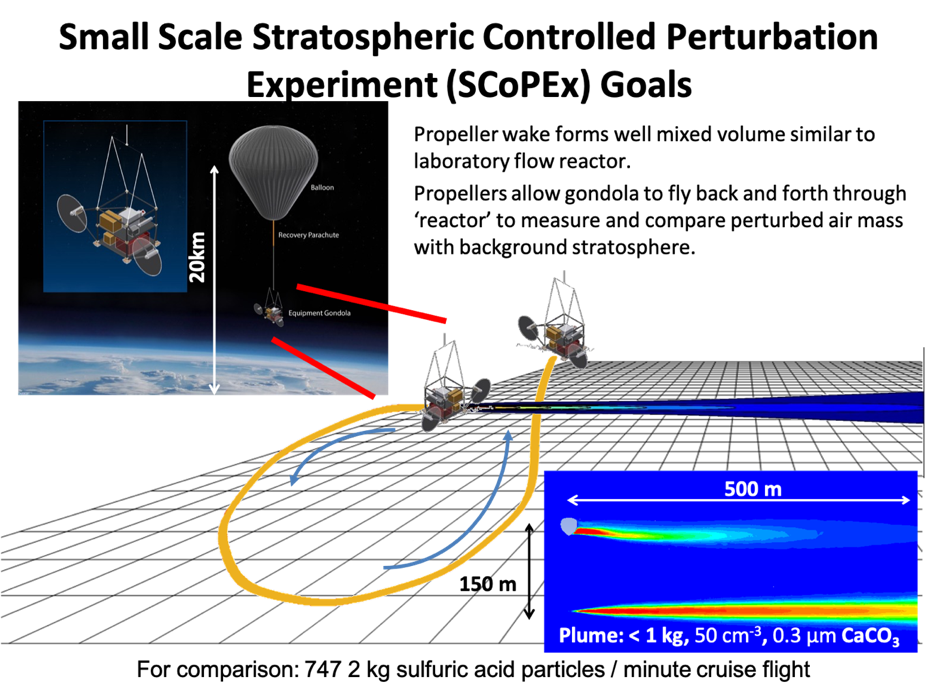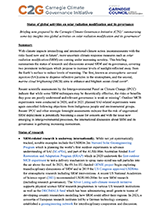Stratospheric aerosol injection could be a painkiller, but not a cure – and more research is needed

[The views of guest post authors are their own. C2G does not necessarily endorse the opinions stated in guest posts. We do, however, encourage a constructive conversation involving multiple viewpoints and voices.]
Research into climate intervention methods, including stratospheric aerosol injection (SAI), is controversial for good reason.
It has to be clear that at best SAI would be a complement to emission reductions, which have to be the absolute priority, and probably carbon dioxide removal. SAI could reduce climate change impacts, but it would not contribute to the ‘solution’.
I often compare SAI to painkillers, opioids, which treat symptoms but don’t solve underlying problems – and their use can delay much needed action on a solution.
This corresponds to my largest concern about the risks of SAI research: the moral hazard. This is the idea that humanity will relax its already feeble efforts on mitigation because of the hope of a ‘painkiller‘.
Also similar to painkillers, there is the danger of addiction to SAI, in which continued use requires higher and higher doses as no action on emissions is taken. Just like sudden withdrawal of opioids can be disastrous, so could sudden cessation of SAI – creating a ‘termination shock’, as the full force of underlying climate change came to bear over the 2-3 year lifetime of stratospheric aerosol. How likely such a scenario would be can be debated, but it certainly has to be considered.
Lastly, the question of whether and what financial interests are encouraging opioid use or supporting SAI research is very important. [1]
The state of our climate emergency today is such that humanity cannot afford to relax. We need invasive surgery – i.e. drastic emission reductions – not just morphine. But there is clearly also utility in painkillers during surgery. And actual painkillers have approval processes and in-depth research.
SAI has not been researched nearly enough to even consider anything close to deployment and research is slow. There are essentially no existing governance processes specific to small-scale outdoor experiments on SAI.
As the principal investigator of the Stratospheric Controlled Perturbation Experiment (SCoPEx) – a proposed experiment that would be the first to inject particles into the stratosphere, but which would begin outdoor testing without particle injection – I share concerns about SAI research.
However, the concern about the risk and uncertainties of SAI is the reason why I believe SAI research (not actual geoengineering) is needed – and why they should also frame the way that research is conducted.
Research to quantify risks and efficacy is needed now. Otherwise it may be too late.
What is known, and not known, about stratospheric aerosol injection (SAI)?
SAI is the idea of introducing particles into the stratosphere, which would scatter sunlight to space and cool the Earth’s surface. Our prediction is that they would stay there for 2-3 years before returning to ground.
Current computer-based models make injecting particles into the atmosphere look good – I fear too good. Some simulations have suggested that combining SAI with emissions cuts could reduce many global climate impacts, such as extreme temperatures, droughts, and tropical storm intensity.
SAI could perhaps be used to slow down the rate of climate change (a rapid rate of change could make it impossible for humanity and ecosystems to adapt), while the slower acting – but more important – emission reductions, and very likely carbon dioxide removal, are taking place.
Yet, there are also tremendous uncertainties and potential risks around SAI. For example, sulfate aerosol, a commonly modelled aerosol due to its natural stratospheric occurrence, destroys the stratospheric ozone layer and heats up the stratosphere, changing atmospheric circulation.
We do not understand stratosphere circulation well enough, and so we cannot know the implications of messing with it without research.
What is SCoPEx?
My team and I have proposed a world-first experiment that could help assess some of the risks and efficacy of SAI.
If we receive permission, our Stratospheric Controlled Perturbation Experiment (SCoPEx) would launch a large research balloon from Esrange Space Center in Kiruna, Sweden. It would rise to approximately 20 kilometers, where we would test its navigation, communication, and instrumentation under extreme stratospheric conditions.
Later, if approved by the independent Advisory Committee, follow-up experiments would release about 2 kilograms of calcium carbonate particles over an area roughly 1 kilometer long and 100 meters wide. (SCoPEx proposes to study calcium carbonate as early indoor research suggests it may cause lower ozone destruction and significantly less stratospheric heating than sulfate.)
The balloon would then turn around to measure whether the particle sizes, locally reflected sunlight, and chemical impact on ozone match our models.
These results and meteorological measurements would then be integrated into global climate models, improving their ability to predict the effectiveness and risks of stratospheric geoengineering.
I fully expect that during the first few flights some of the instruments will fail, or – more difficult – produce unreliable data. The instruments will have to operate at ambient temperatures of -60°C at low pressures, which can result in different parts of the same instrument overheating and getting too cold, and laser optics can distort.
This will have to be evaluated carefully and problems will have to be fixed before actual scientific data can be obtained, which is an example of why stratospheric experimental research is slow.
However, there are no existing observational data that can be used to provide empirical evidence for models on lower-risk SAI materials or particle plume evolution, which is why limited experiments, such as SCoPEx, are critical.
My motivations for this experiment
I am conducting this research not because I am an advocate for the large-scale deployment of SAI, but rather because the state and direction of climate change makes me extremely concerned that such an approach will be considered at some point.
One of the issues that keeps me up at night concerns sulfate aerosol, a commonly modelled aerosol due to its natural occurrence, including from volcanic eruptions such as Mount Pinatubo.
Sulfate not only destroys the stratospheric ozone layer but also heats up the stratosphere. A large scientific community is trying to better understand stratospheric dynamics, the circulation of air in the stratosphere, which connects to the troposphere where we live, and even the oceans.
By heating up the stratosphere we would be messing with a system we do not understand well enough. In addition, we don’t really understand how a plume of particles will evolve from a point source to the enormous grid boxes of climate models.
These are just two specific examples of why we need to conduct research into particles that may have fewer side effects, such as less ozone destruction and reduced impacts on circulation, and how the particles will actually behave.

Reducing moral hazard and slippery slopes through governance
In view of the concerns about moral hazard (which I explained above), and also about a potential slippery slope – whereby experiments could evolve into deployment, which I share – an important question is how to conduct research.
The issue lies not in the physical risk of SCoPEx, which is the same as any stratospheric balloon flight as it will emit less than an aircraft or rocket releases in a few minutes of flight. The risk lies in the implications.
This is why SCoPEX has an independent advisory committee that conducts financial, legal, safety and science reviews, as well as a societal engagement plan. SCoPEx only proceeds with each experimental step with committee approval. The advisory committee is in the process of deciding on a test flight without any particle injection. Originally, the decision was planned for February but the committee is still deliberating, which reflects the complexity of this project.
Is this process perfect? Almost certainly not. But in the absence of other governance mechanisms which adequately address the complex nature of this novel project the committee plays a critical role in the development of future governance mechanisms. The development of research governance is as important as the research itself.
The risk of moral hazard of SAI research also has to be weighed against the risk of no research.
Due to the enormity of the integrated greenhouse gases emissions, there is no fast solution with low impact.
The IPCC tells us that if we cut emissions over the next decades we can stay below 1.5°C. However, not obvious in such statements, is that vast areas of land might be used for bio-energy with carbon capture and storage (BECCS) depending on the the exact scenario (e.g. 1.6 times the EU land area by just 2050). The profound impacts of such staggering land use changes have to be made clearer.
Winners and losers
I believe that any solution to climate change will have profound impacts, creating winners and losers. Among the latter are likely to be those who are not at fault, in the Global South and future generations.
In view of this reality, I am extremely concerned that at some point in the not too distant future it will be the responsibility of decision makers to consider SAI and other geoengineering methods. If these methods suggest a substantial reduction in human suffering, as computer models do in some respects, SAI could look incredibly attractive.
If populations demand that decision makers take action rather than talk about taking action, SAI may be the only fairly fast option, and SAI could be cheap when not considering the holistic costs.
Will lack of research on risks and efficacy of SAI prevent decision makers of considering it? I think not. If decision makers make poor decisions because of no research, can they be blamed? As research is slow we need to start doing this research now.
As a scientist, I have no say on the decisions that society ultimately takes. But I can help provide facts for those who do.
_______________
[1] SCoPEx does not accept anonymous donations, nor donations from corporations, foundations or individuals if the majority of their current profits or wealth come from the fossil fuel industry, unless they can clearly demonstrate that they do not have a conflict of interest and present a strong track record of supporting efforts to address climate change. SCoPEx also does not file any patents on technologies developed, and will make them publicly available.



A lucid, measured and convincing proposition of the case for SAI.
At such small levels of particle injection, we should not be afraid to
carry out, and repeat the exercise to give the quickest and fullest
data possible for Stratospheric distribution.
I hope the case for SAI is to be presented at COP26.
The accomplishments of this research governance seem to have been: no research over eleven years since SPICE. Or at least no public research. It doesn’t seem like there is any benefit to this governance whatsoever. This is as opposed to iron fertilization, where we got a real answer fairly quickly. The benefit, if any, that this governance seems to have is it allows the parties involved to keep pretending that this might work without any real evidence.
Thank you for your thoughtful and cautious approach to the issue of SAI. I support your efforts to obtain vital information about the potential negative impacts of this technology.